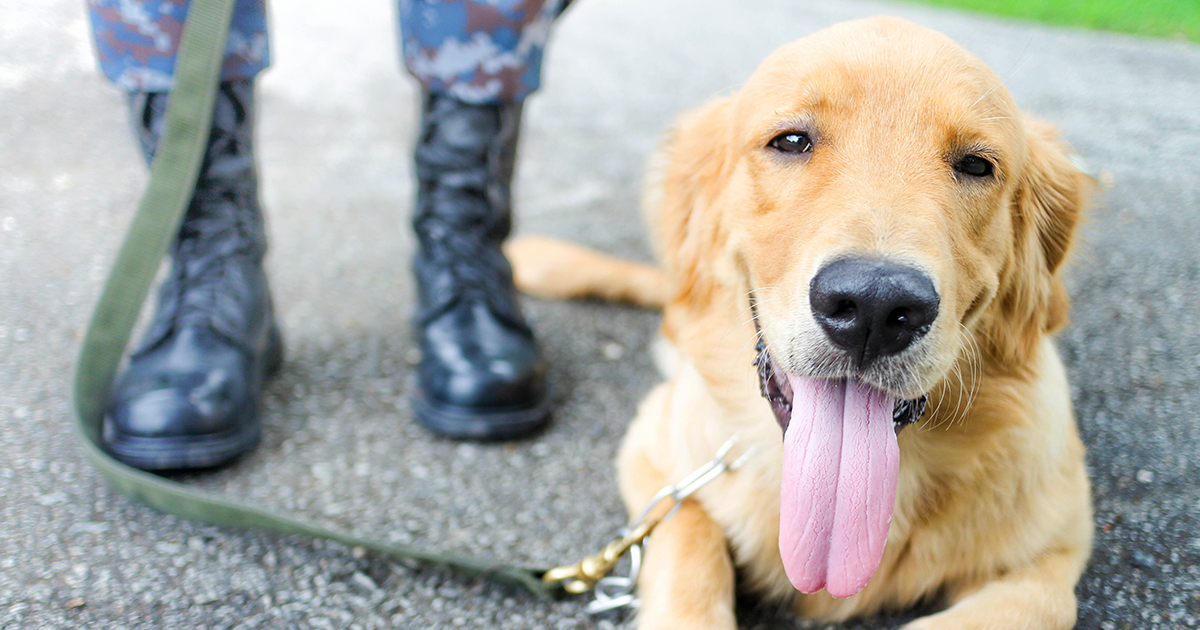Tomorrow (March 13, 2019) is National K9 Veterans Day, a day that pays tribute to the military working dogs and countless other canines who have served our country. The holiday also commemorates the launch of the U.S. Army’s original War Dog Program, or “K9 Corps.”
What you may not know is that military working dogs have served alongside U.S. soldiers since the Revolutionary War. Today, there are an estimated 2,300 military working dogs; most serve stateside to ensure the security of military bases. A couple hundred others are deployed with their handlers to war zones where they serve as patrol dogs, sentries, and explosives and drug detectors.
But what becomes of these working dogs when their military career ends?
We’ll answer that question and explain what you need to know if you’re interested in giving one of these retired military “veterans” a home.
WHEN AND WHY MILITARY WORKING DOGS STOP SERVING
Like human recruits, not all puppies initially destined for the military working dog program complete the full training to become active duty dogs. Those pups not selected for advanced training may be offered up for adoption.
In addition, every working dog’s career comes to an end at some point. It can be due to injuries, health conditions, age or even behavioral issues, such as loss of drive or being easily distracted. Some dogs may go on to work in another federal agency or law enforcement. But if their health doesn’t allow them to continue working, the dogs are made available for adoption.
U.S. federal law gives priority first to civilian law enforcement agencies, then to prior handlers, and finally to the general public. But if age, fitness or medical issues keep the dog from being considered for law enforcement duties, then a former handler is most often selected. In fact, most retired military working dogs — more than 90 percent — are adopted by their current or former handlers.
While the various government agencies have different guidelines for adopting retired or reassigned dogs, you can expect a thorough application and interview process. These adoption programs take as much care in adopting out dogs as they do in selecting, training and placing their dogs in military service.
You can also expect a long wait to adopt a military working dog. Only a small number of dogs are available for civilian adoption, and there’s a long list of interested prospective owners. Because of this, you could wait for 12 to 18 months before your application to adopt a retired working dog is pulled.
NOT YOUR REGULAR FAMILY DOG
Before starting the adoption process, prospective owners of military working dogs need to recognize that these dogs are not like most family dogs. Whether they have served at an overseas base or at an airport in the United States, military working dogs were selected for their intelligence, drive and focus. Structure and obedience are important for these dogs.
You might envision a military working dog as a German shepherd, but that isn’t the only breed found in these programs. Other breeds include Dutch shepherd, Labrador retriever, Belgian Malinois and German shorthaired pointer.
Most retired military working dogs available for adoption will be around 10 to 12 years old. If dogs have health issues that impact their ability to serve, they may be younger. In addition, dogs being released from either the TSA or Armed Forces training program are also likely to be younger, possibly 2 to 4 years old.
The level of training that each dog received will also vary, particularly if the dog is being removed from a program. And you can rest assured that every dog will be carefully evaluated during behavioral tests prior to adoption. However, potential adoptive families usually cannot have kids under age 5 in the home because most of the dogs aren’t good fits for such an environment.
WHO TO CONTACT ABOUT WORKING DOG ADOPTION
Joint Base San Antonio–Lackland (commonly known as Lackland Air Force Base), the Texas base where all military dogs and their handlers are trained, handles all of the adoptions for the U.S. Armed Forces. The TSA handles the adoptions of airport security working dogs. Mission K9 Rescue, a nonprofit organization based in Houston, Texas, helps facilitate adoptions of contract military working dogs, military working dogs and police department dogs.
If you’re interested in adopting a retired or reassigned military working dog, consider reaching out to the adoption coordinators or submit an application. And if you live within two to three hours of San Antonio, you may want to consider applying to the military working dog foster program.







